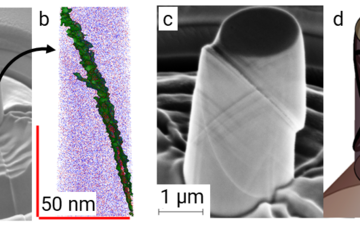All genres
1161.
Talk
Ab inito study on elastic properties of Fe3Al-based alloys. MRS Fall Meeting 2008, Boston, MA, USA (2008)
1162.
Talk
Application of Spectral Methods for Anisotropy Design of Ti-Nb Polycrystals for Biomedical Applications based on ab Initio Elastic Single Crystal Constants and Fast Fourier Homogenization. MRS Fall Conference 2008, Boston, MA, USA (2008)
1163.
Talk
Ab-initio based growth simulations of GaN based nanowires. MRS fall meeting, Boston, MA, USA (2008)
1164.
Talk
Hierarchical Modeling of the Elastic Properties of Lobster Cuticle via Ab Initio Calculations and Mean-field Homogenization. MRS Fall Conference 2008, Boston, MA, USA (2008)
1165.
Talk
Ground-state structure and elastic anisotropy of crystalline alpha-chitin: An ab-initio based conformational analysis. Materials Research Society meeting (MRS), Boston, MA, USA (2008)
1166.
Talk
Multiscale Modelling of the Elastic Properties of Biological Polymer-Based Nanocomposites with Hierarchical Microstructure: The Lobster Cuticle. 3rd International Conference on Polymer Behaviour, Marrakech, Morocco (2008)
1167.
Talk
Ab initio based modeling of engineering materials: From a predictive thermodynamic description to tailored mechanical properties. Multiscale Materials Modeling 2008, Tallahassee, FL, USA (2008)
1168.
Talk
Understanding the phase transformations of the Ni2MnGa shape memory system. (2008)
1169.
Talk
Modeling of the strain-induced interaction between carbon atoms in Fe-C solid solution using embedded atom method potential. Contemporary Problems of Metal Physics, Kiev, Ukraine (2008)
1170.
Talk
Design of engineering materials based on ab initio thermodynamics and kinetics. Materials Science and Technology 2008, Pittsburgh, PA, USA (2008)
1171.
Talk
Ab initio study of Thermodynamics and adatom kinetics on non-polar GaN surfaces: Consequences on the growth morphology and the formation of nanowires. International Workshop on Nitride Semiconductors, Montreux, Switzerland (2008)
1172.
Talk
Ab initio based design of alloys. MS&T'08, Symposium: Discovery and Optimization of Materials Through Computational Design, David Lawrence Convention Center, Pittsburgh, PA, USA (2008)
1173.
Talk
Multiscale design of aluminium alloys based on ab-initio methods. ICAA 11 – 11th International Conference on Aluminium Alloys 2008, Aachen, Germany (2008)
1174.
Talk
Growth simulations of non-polar GaN surfaces: Thermodynamics, kinetics and dopant incorporations. Bremen DFG Forschergruppe: Workshop in Riezlern, Reizlern, Austria (2008)
1175.
Talk
Modeling of electronic and optical properties of GaN/AlN quantum dots by using the k.p-method. Bremen DFG Forschergruppe: Workshop in Riezlern, Riezlern, Austria (2008)
1176.
Talk
Homogenization in Polycrystal Mechanics on the Basis of First Principles Simulations. IUTAM Symposium on Variational Concepts in Materials Mechanics, Ruhr-Universität Bochum, Germany (2008)
1177.
Talk
First Principles Predictions of Mechanical Properties of FeMn-Alloys. Workshop des SFB761, Beilngries, Germany (2008)
1178.
Talk
First Principles Calculation of Stacking Fault Energies of FeMn-Alloys. Materials Science and Engineering (MSE08), Nürnberg, Germany (2008)
1179.
Talk
Ab initio study on elastic properties of Fe3Al-based alloys. Materials Science and Engineering (MSE'08), Nürnberg, Germany (2008)
1180.
Talk
First principles determination of thermodynamic properties of metals. Materials Science and Engineering (MSE08), Nürnberg, Germany (2008)











